
With your New Year’s Eve hangover in the rear view mirror and the long, winding road of 2014 laid out before you, here are 5 wine-related resolutions to help you embrace and explore the world of wine in the New Year.
1.) Mix It Up: Because the world of wine is so vast and often confusing it’s easy to just stick with the same wine, day in and day out. To break out of your wine rut, why not vow to sample a different wine every week or learn more about a specific wine making region? Find a reputable retailer who can guide you towards selections you might like or subscribe to a publication and/or website where you can learn more about a variety of wine regions around the world. Here on the blog we plan on offering an array of wine coverage in the New Year and our Explorateur Wine Club is a wonderful way to explore a different wine region every month!
2.) Start a Wine Collection: If you’ve been drinking wine long enough to have a favorite wine region and/or producer it’s probably a good time to start collecting. Collecting wine does not mean you have to commission a custom built 15,000 bottle capacity cellar – far from it! All it takes to start a collection is a small wine fridge and a few age-worthy bottles to put in it (for some age-worthy wine recs, please click here). The wine fridge is an important piece of equipment for the beginning collector. Please don’t forgo this purchase and make the mistake of storing your wines in a spare closet or on the kitchen counter. The varying temperatures and humidity levels in any home (kitchens are the worst!) are the arch-enemies of wine so be sure to protect your investment with this useful piece of equipment. Also, wine lovers invariably have a way of outgrowing wine storage units so, if your budget allows, purchase a fridge with a little room to grow.
3.) Drink more white wines that are NOT Pinot Grigio: Much like Rodney Dangerfield, white wine often “gets no respect”. I conduct many tastings where people want to skip right over the white wine and go straight to the red. Sometimes it’s personal preference but, more often than not, I think people are under the impression that red wines are somehow superior to whites, which couldn’t be farther from the truth! People are also under the mistaken impression that all white wine tastes like the bland, mass-produced Pinot Grigios we often encounter which doesn’t help white wine’s reputation. It’s rewarding to see someone’s face light up after taking a sip of White Burgundy or Alsatian Gewürztraminer and marvel at their flavor and complexity. So whether it’s Gewürztraminer, Viognier, Arneis or Chenin Blanc embrace the world of white wine but, whatever you do, stay away from the Pinot Grigio! For a selection of delicious whites from The Wine Atelier, please click here.
4.) Drink more sparkling wines: Unfortunately sparkling wines are most often associated with special occasions and New Year’s Eve celebrations, leaving the majority of the year unbearably bubbly-free. While Champagne’s price may limit it to more of a special occasion selection, there are many sparkling wines from around the globe whose price point makes them a perfect candidate for an everyday wine. Wines like Prosecco, Cava and Crémant retail for under $20 (for some examples, please click here) making them perfect for enjoying on a Tuesday night after work or when a friend stops by to visit. As an added bonus, sparkling wines have less calories and alcohol than a glass of Chardonnay or Pinot Noir. Affordable, delicious and figure-friendly – what’s not to love about that?
5.) Wine-related Travel: Next time you’re booking a Spring or Summer getaway why not head to your favorite wine region? Nothing will give you an appreciation for what’s in your glass more than standing in the vineyard where the grapes are grown and talking to the people who make the wine. Whether you’ve collected for some time or are new to enjoying wine, traveling to different regions can be a lot of fun and facilitate your passion for the subject. Start with a region you’re interested in and plan from there. Don’t be afraid to reach out to the wineries directly, they’re usually very happy to hear from you. Of course here at The Glamorous Gourmet we’re always happy to assist you with wine and food related travel so please don’t hesitate to reach out. Here’s a link to some of our travel-related articles.
I hope these suggestions help you make it through 2014 with a renewed passion for all things vinous! If you have any other wine-related resolutions we’d love to hear about them, please tell us in the comment section below.
Cheers,
![]()

Happy New Year, my fellow food and wine lovers! I hope your 2014 is off to a great start and that you rang in the New Year surrounded by loved ones as well as delicious food and wine. While the presence of Champagne at an event is usually enough to indicate a celebration is at hand, there’s a way to even kick it up another notch: the art of sabrage.

Believed to have been invented by Napoleon during the French Revolution, sabrage is the technique of opening a bottle of Champagne using a saber. Legend has it, as Napoleon and his troops returned home victorious from battle, the townspeople handed them bottles of Champagne to show their appreciation and gratitude. Because they were mounted on horseback, it was too difficult to put down the reins to pop the cork, so they used their sabers and voila, the art of sabrage was born! In another version of the story, the widow (Veuve) Clicquot was involved, giving Napoleon’s officers Champagne in return for protecting her land during this time of political unrest.

Contrary to popular belief, sabrage is not actually “chopping” the top of the Champagne bottle off. In fact, not much “muscle” is required at all to actually behead the bottle. The technique essentially utilizes the pressure present in the bottle (approximately 6 atmospheres) combined with a quick whack from the saber to effectively “pop” the seam of the bottle at its weakest point, where it comes together at the neck. Although there are “Champagne sabers” made especially for this process, Laguiole makes a very nice one (see above photo), you don’t have to use one to perform this technique. The back of a Chef’s knife works just as well. Just be sure not to use the sharp end of the knife as you can damage the blade.
While sabrage is a pretty easy skill to learn, there are a few very important things to keep in mind in order to do it safely:
1.) Be sure the bottle of bubbly is VERY cold: If the bottle hasn’t been in the refrigerator since at least the night before, you may want to rethink using it. Without a properly chilled bottle, you run the risk of the bottle exploding during the process and nothing puts a damper on a party like an exploded bottle of Champagne.
2.) Find the seam on the bottle: Most Champagne bottles have a seam that runs vertically from the neck to the bottom where the two halves of the bottle are joined together. You can easily find it by running your finger around the circumference of the bottle until you find the ridge. This seam is the guide your saber will follow along the bottle, making contact with the neck exactly where it intersects with the seam.
3.) Adjust the wire cage and remove paper/foil from the neck of the bottle: In order to clear the runway for your saber or knife, you’ll need to adjust the cage, the wire which surrounds the cork, up one notch so the blade of the saber hits the neck of the bottle, not the wire of the cage. Simply untwist the wire, slide the cage up one notch to expose the neck, and twist to refasten it around the cork. Be very careful, however, because once the wire cage is loosened, the cork can unexpectedly pop out at any time. You could remove the cage altogether but I find keeping the cage on not only makes the cork easier to find in an outdoors setting, but also make a nicer presentation. At this point, also remove any foil or paper around the neck so your saber has an unobstructed path to follow.
4.) Hold the bottle properly: There are two ways to hold your bottle of bubbly for performing sabrage: either with your thumb in the “punt” (the indentation in the bottom of the bottle) and your fingers supporting the bottle from underneath, or by simply grasping the bottle around the base. Experiment with each and go with whichever one feels more natural and secure.
5.) Point the bottle away from friends, family and windows: Ideally sabrage is performed outside but when that isn’t possible, be sure the bottle is aimed away from friends, family or anything breakable. In the video below, I didn’t use as much force as I normally would because I didn’t want to take out any ornaments on the Christmas tree, not to mention any of the windows.
6.) Let ‘er rip: When you’re ready to go, hold the Champagne bottle away from you pointed upwards at a 45 degree angle to the ground and run the blade along the seam, taking a few practice strokes. Then, briskly slide the blade along the seam with an “up and out” motion and pop the top right off that bottle!
7.) Wipe off the neck of the bottle and serve: Once the deed is done and the applause has quieted, it’s time to enjoy the fruits of your labor. Luckily, the pressure inside the bottle ensures no glass gets into it, however, it’s always smart to wipe off the top of the bottle with a kitchen towel just to be sure there’s no glass fragments remaining. Then, you’re free to serve your guests but no matter what you do, don’t ever attempt to drink from a freshly sabered Champagne bottle! The edges are extremely sharp and this gaff will take you from hero to zero in seconds flat.
In case you’re wondering what the process looks like, below is a video of me sabering a bottle of Taittinger Brut Rosé for our first guests on New Year’s Eve. As I mentioned previously, I didn’t use as much force as I normally would in order to spare the windows and Christmas tree ornaments. I hope you have fun experimenting with the art of sabrage and remember the immortal words of Napoleon, “In victory you deserve Champagne, and in defeat, you need it.”
Cheers,
![]()
If you are a fan of food and wine and plan most of your travel around taking in the culinary and vinous sights you won't want to miss this very special Day Trip to Burgundy with The Cook's Atelier. Beaune is a mere 2 hour train ride from Paris on the TGV high speed train and a visit to this incredibly charming town is so worth it.We had the pleasure of spending a truly delightful day in Beaune, the wine capital of Burgundy, with Marjorie Taylor and her daughter Kendall Smith Franchini, Founders of The Cook's Atelier. Originally from the US, Marjorie and Kendall followed their bliss to France and started their new venture five years ago. Kendall had been living in France for ten years, going to school and then working for Christie's Auction House and wine importer Kermit Lynch. Marjorie was co-chef proprietor of the award-winning restaurant and cooking school, Ruby Beet Gourmet, in Phoenix, Arizona prior to making the move overseas. She had also studied at La Varenne cooking school under noted teacher and cookbook author, Anne Willan. Together, this mother daughter team decided they wanted to be on the same side of the pond and now offer market tours and hands-on cooking classes to students lucky enough to score a spot in one of their highly coveted classes. And for good reason, the "Market Tour & Lunch" class we experienced was hands down one of the highlights of our trip and the perfect option for a Day Trip to Burgundy.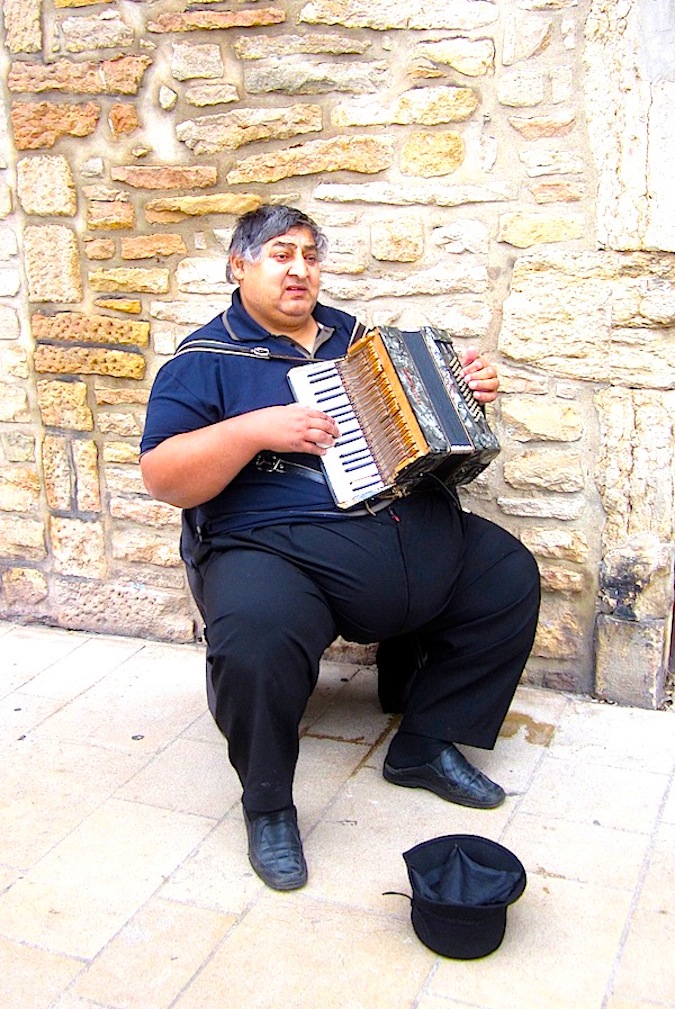
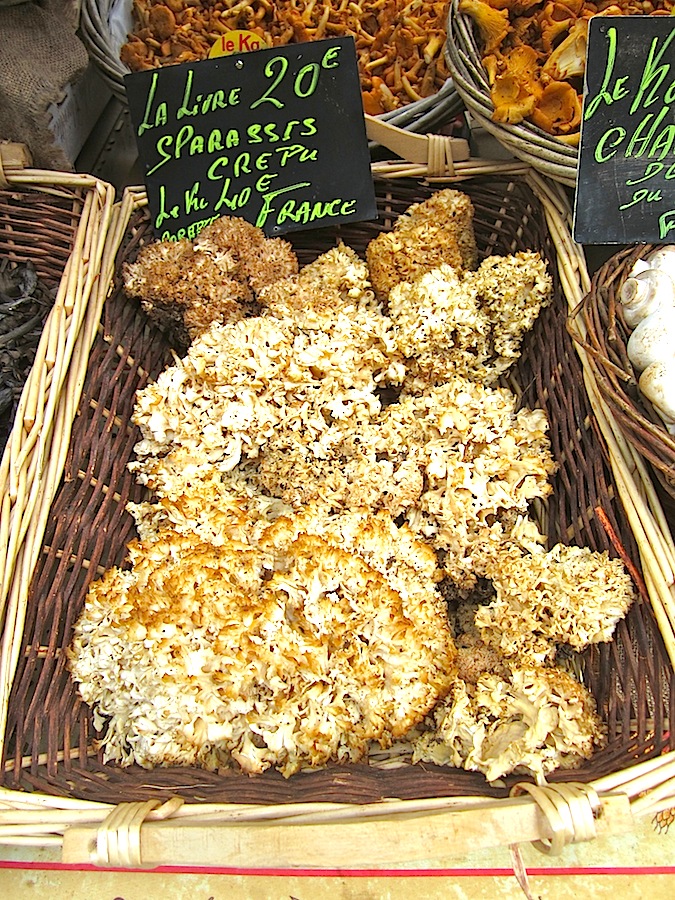
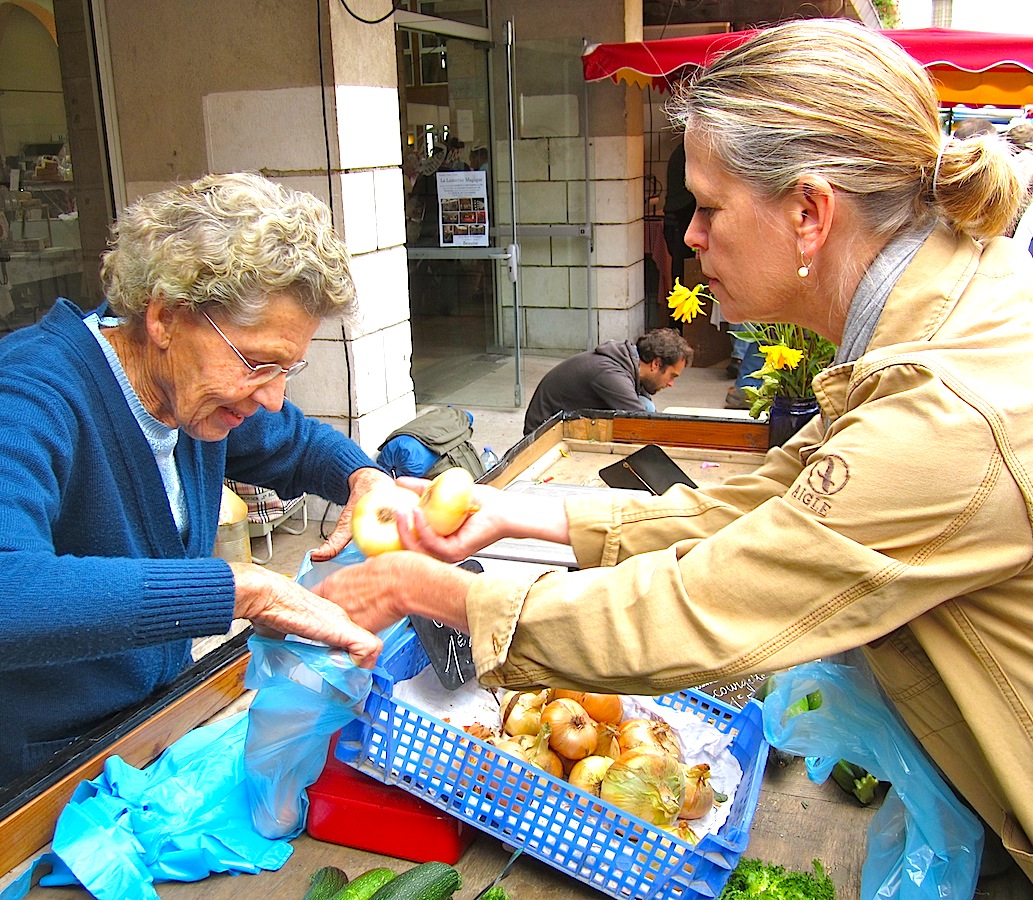
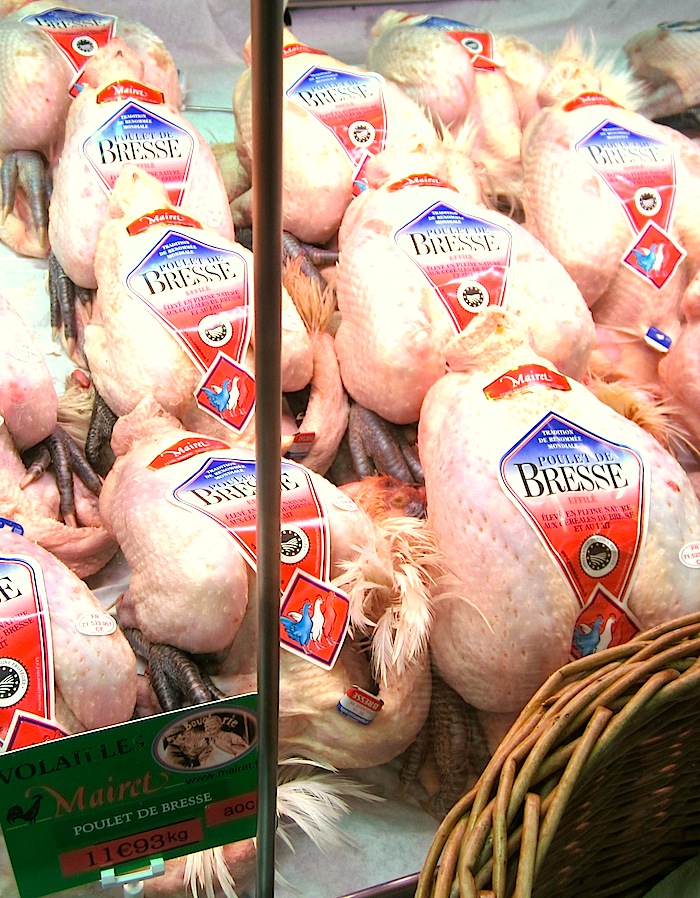 Many people had recommended we see the Beaune market during our visit and we considered ourselves very fortunate to have Marjorie as our guide - there was so much to see! As we made our way through the vast marketplace, Marjorie introduced us to her favorite purveyors of produce, meats and cheeses. Everything from Bresse chickens to Truffe de Bourgogne beckoned - it was truly a feast for the senses. After we had procured the ingredients for our lunch, we took the short walk through the charming town of Beaune to the "atelier" (French for studio or workshop), a small but very elegant and inviting space. A beautiful zinc-topped farm table was the room's focal point as well as a large chalkboard featuring the day's menu. Two generously sized windows allowed sunlight to stream in, giving the space an ethereal feel and making for ideal food photography (coincidence?). To the right was the kitchen, already appointed with work stations where we would all help prepare the day's meal. Everyone got to participate and Marjorie was a very relaxed and patient instructor not to mention the lady can cook!
Many people had recommended we see the Beaune market during our visit and we considered ourselves very fortunate to have Marjorie as our guide - there was so much to see! As we made our way through the vast marketplace, Marjorie introduced us to her favorite purveyors of produce, meats and cheeses. Everything from Bresse chickens to Truffe de Bourgogne beckoned - it was truly a feast for the senses. After we had procured the ingredients for our lunch, we took the short walk through the charming town of Beaune to the "atelier" (French for studio or workshop), a small but very elegant and inviting space. A beautiful zinc-topped farm table was the room's focal point as well as a large chalkboard featuring the day's menu. Two generously sized windows allowed sunlight to stream in, giving the space an ethereal feel and making for ideal food photography (coincidence?). To the right was the kitchen, already appointed with work stations where we would all help prepare the day's meal. Everyone got to participate and Marjorie was a very relaxed and patient instructor not to mention the lady can cook!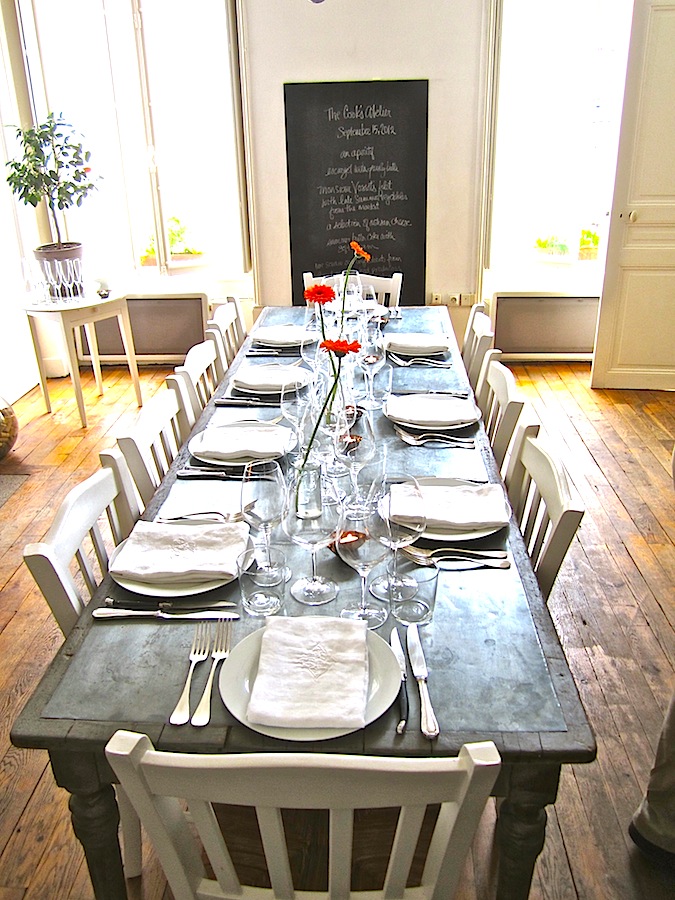
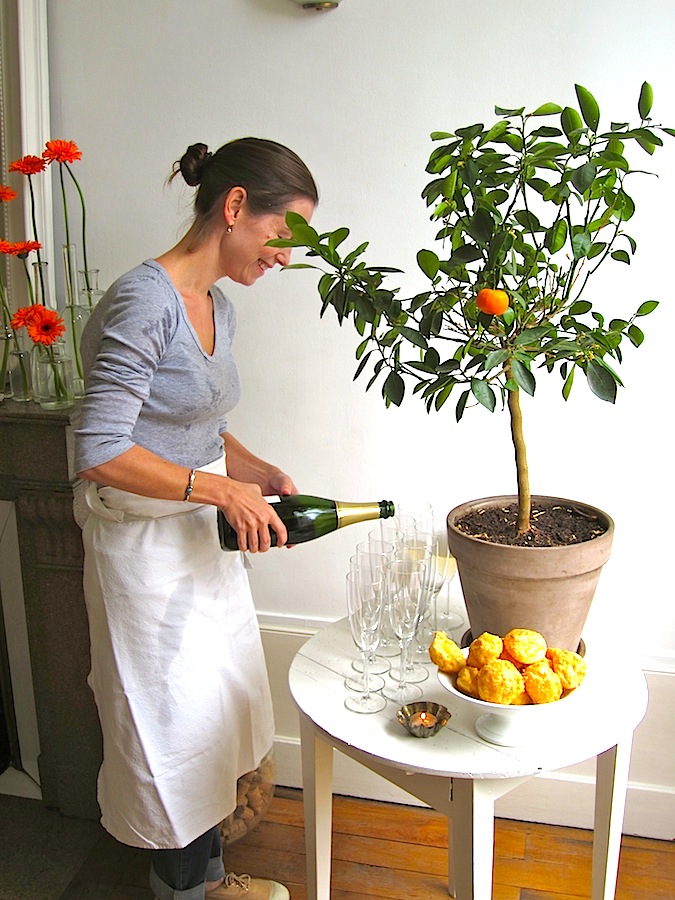
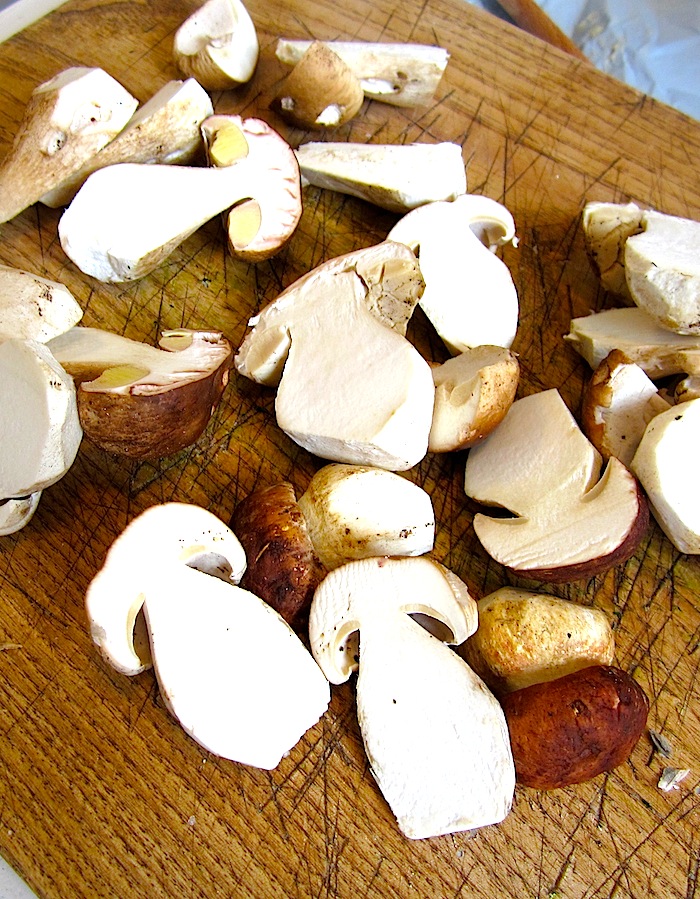
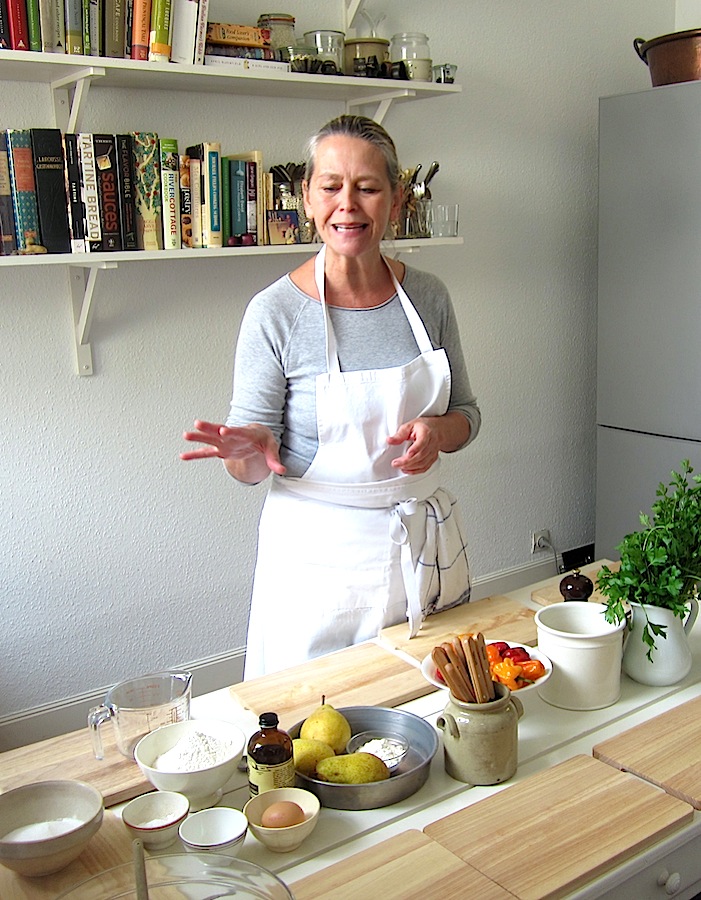
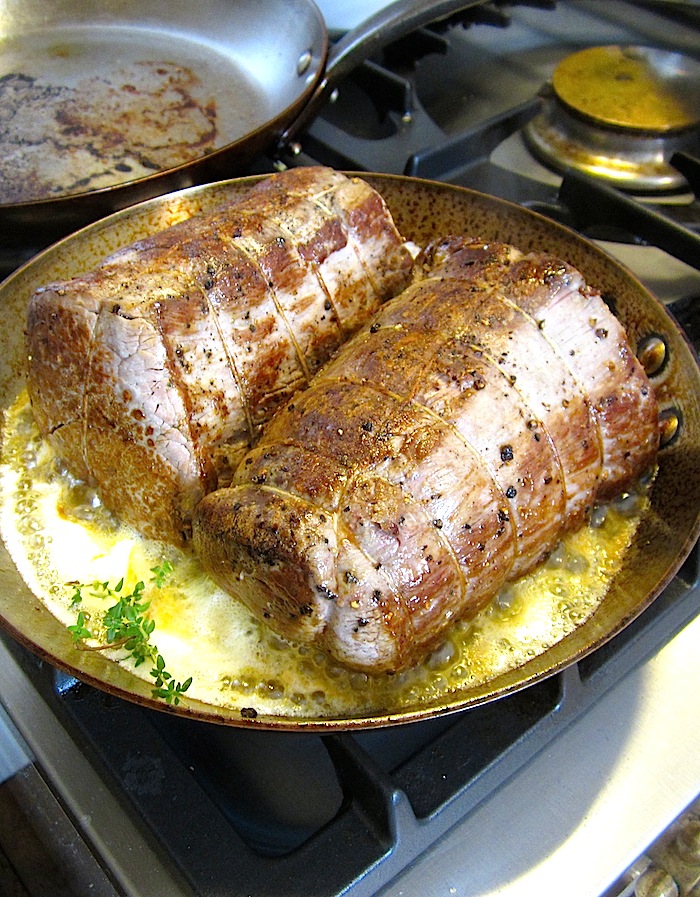 Once finished, we were treated to chilled flutes of Crémant de Bourgogne, Burgundy's sparkling wine, paired with Marjorie's delicious Gougeres which, up until that day, had always seemed too daunting to make. They were warm and divine right out of the oven and took the edge off of our hunger which we were just starting to notice. Soon after we sat down to a beautiful meal of Escargot with Parsley Butter followed by Monsieur Vossot's Filet of Beef with Late Summer Vegetables and Roasted Potatoes with Thyme. By the time our dessert of Summer Butter Cake with Soft Cream arrived at the table we had become fast friends with our fellow students, also visitors from other countries around the world.
Once finished, we were treated to chilled flutes of Crémant de Bourgogne, Burgundy's sparkling wine, paired with Marjorie's delicious Gougeres which, up until that day, had always seemed too daunting to make. They were warm and divine right out of the oven and took the edge off of our hunger which we were just starting to notice. Soon after we sat down to a beautiful meal of Escargot with Parsley Butter followed by Monsieur Vossot's Filet of Beef with Late Summer Vegetables and Roasted Potatoes with Thyme. By the time our dessert of Summer Butter Cake with Soft Cream arrived at the table we had become fast friends with our fellow students, also visitors from other countries around the world.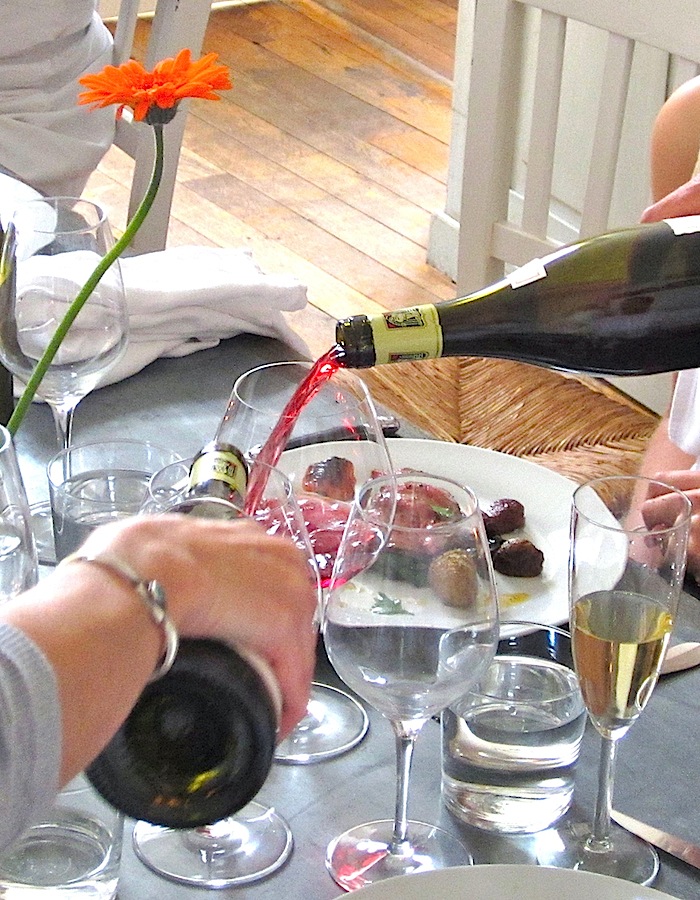
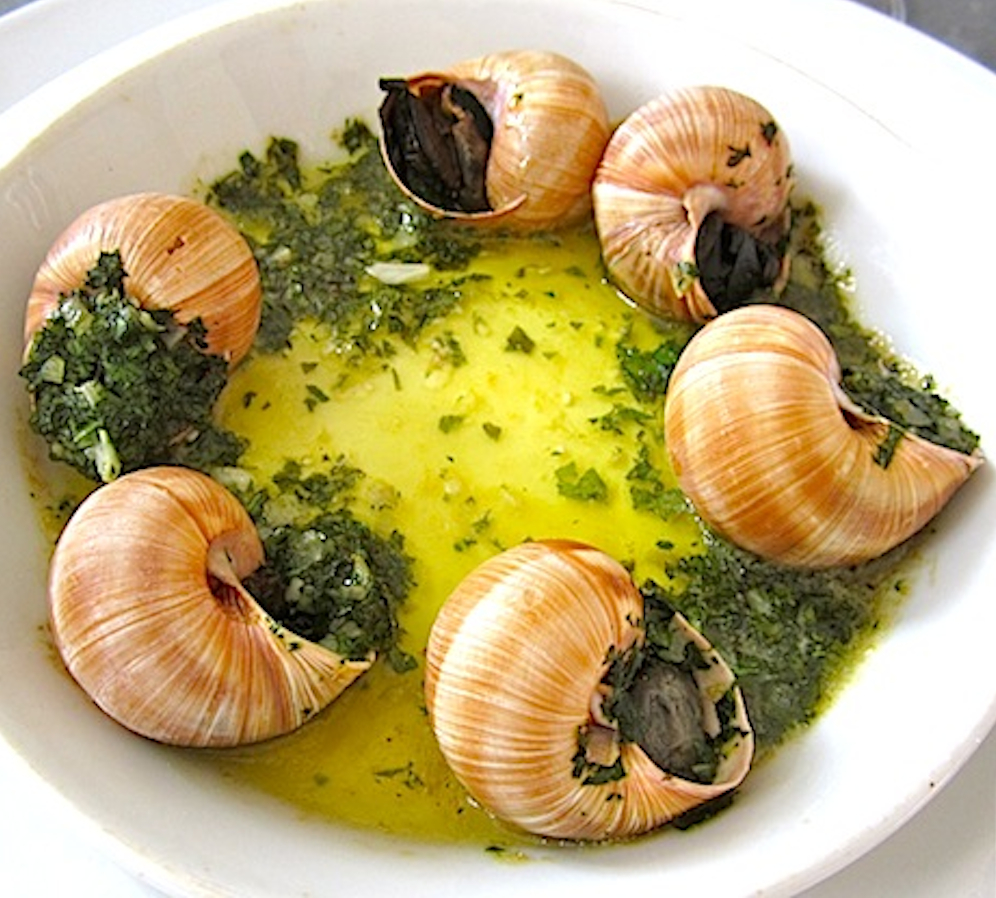
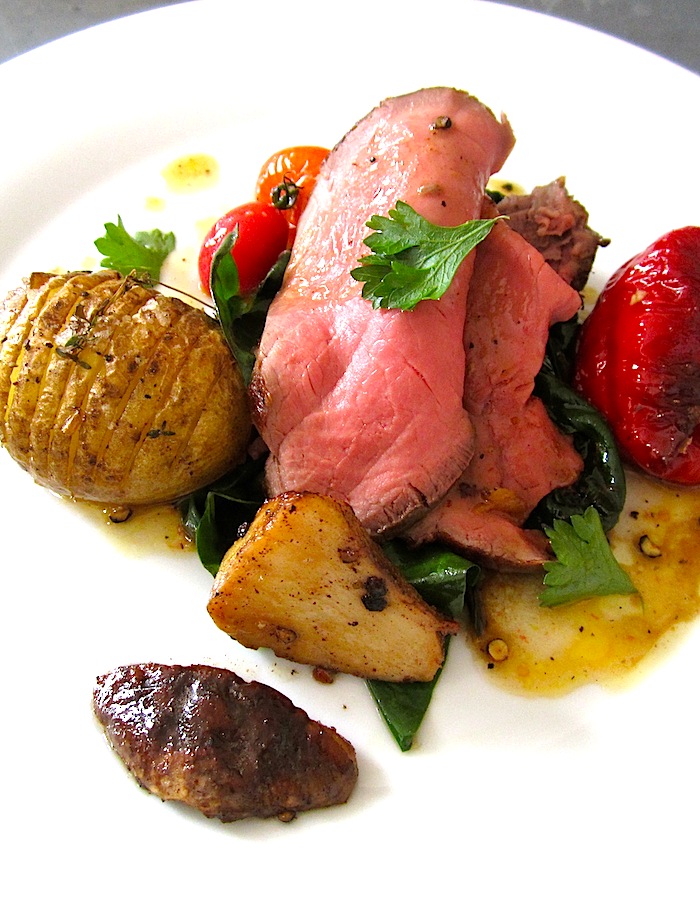
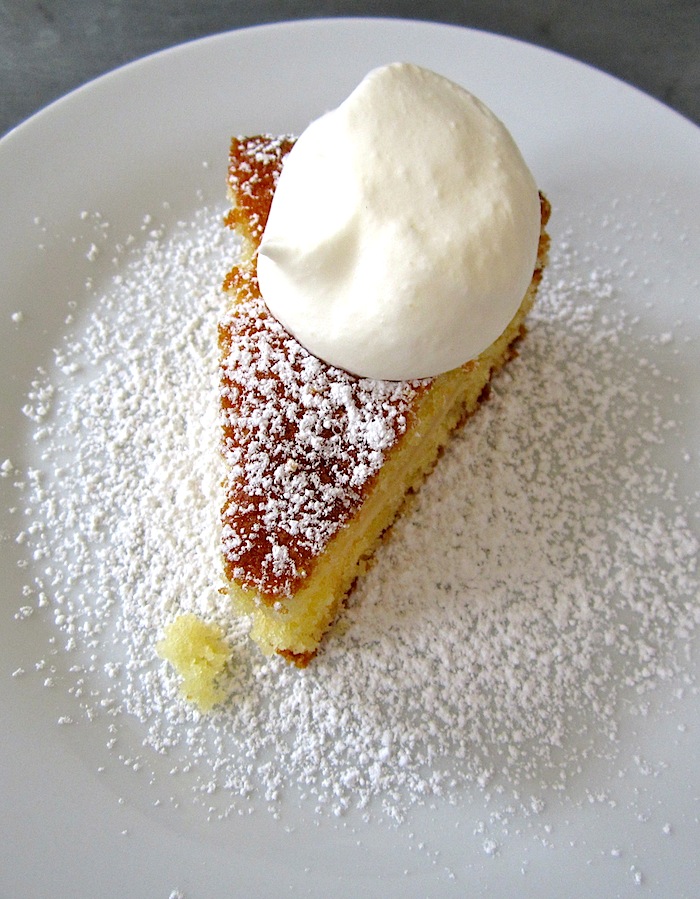 With our meal we enjoyed local wines made from Chardonnay and Pinot Noir (Burgundy's specialty!) and since we also visited Maison Louis Jadot and Maison Joseph Drouhin during our trip I'd like to suggest a few of their wines to pair with this delicious meal. Burgundy is generally a pricy proposition, however, if you're looking for two great values, try the 2011 Drouhin Vaudon Chablis ($25) a citrusy, flinty Chardonnay with a racy acidity which will pair nicely with the rich escargot. For a red, try the 2010 Louis Jadot Chateau de Jacques Morgon ($32) with notes of black cherry and currant with a lovely minerality and supple tannins. If you're looking to kick it up a notch for New Year's Eve, try the 2010 Louis Jadot Meursault ($54), a rich, mineral-tinged white made from 100% Chardonnay, which would make a lovely pairing for the escargot. The 2009 Joseph Drouhin Clos de Mouches ($95), a delicious, cherry and spice-laced red with silky tannins made from 100% Pinot Noir, would complement the filet of beef beautifully. By the time we had finished our "lunch" it was around 5pm, and we were in no rush to leave the "atelier" with its deliciously inviting atmosphere. Reluctantly, we eventually said our goodbyes and made our way back to our hotel. All in all it was a fabulous and memorable day!To access any of the above recipes, just click the recipe names which will take you directly to The Cook's Atelier website. If your travels bring you to France, hopefully you'll be able to enjoy a Day Trip to Burgundy with Marjorie and Kendall to enjoy some of the special culinary delights this very special city has to offer.Bon appétit,
With our meal we enjoyed local wines made from Chardonnay and Pinot Noir (Burgundy's specialty!) and since we also visited Maison Louis Jadot and Maison Joseph Drouhin during our trip I'd like to suggest a few of their wines to pair with this delicious meal. Burgundy is generally a pricy proposition, however, if you're looking for two great values, try the 2011 Drouhin Vaudon Chablis ($25) a citrusy, flinty Chardonnay with a racy acidity which will pair nicely with the rich escargot. For a red, try the 2010 Louis Jadot Chateau de Jacques Morgon ($32) with notes of black cherry and currant with a lovely minerality and supple tannins. If you're looking to kick it up a notch for New Year's Eve, try the 2010 Louis Jadot Meursault ($54), a rich, mineral-tinged white made from 100% Chardonnay, which would make a lovely pairing for the escargot. The 2009 Joseph Drouhin Clos de Mouches ($95), a delicious, cherry and spice-laced red with silky tannins made from 100% Pinot Noir, would complement the filet of beef beautifully. By the time we had finished our "lunch" it was around 5pm, and we were in no rush to leave the "atelier" with its deliciously inviting atmosphere. Reluctantly, we eventually said our goodbyes and made our way back to our hotel. All in all it was a fabulous and memorable day!To access any of the above recipes, just click the recipe names which will take you directly to The Cook's Atelier website. If your travels bring you to France, hopefully you'll be able to enjoy a Day Trip to Burgundy with Marjorie and Kendall to enjoy some of the special culinary delights this very special city has to offer.Bon appétit,

Lately, folks have been asking me what I’ll be making for dinner this New Year’s Eve, and what could be better than a meal inspired by a recent trip to France’s Burgundy wine region?
Last September we had the pleasure of spending a truly delightful day in Beaune, the wine capital of Burgundy, with Marjorie Taylor and her daughter Kendall Smith Franchini, Founders of The Cook’s Atelier. Originally from the US, Marjorie and Kendall followed their bliss to France and started their new venture five years ago. Kendall had been living in France for ten years, going to school and then working for Christie’s Auction House and wine importer Kermit Lynch. Marjorie was co-chef proprietor of the award-winning restaurant and cooking school, Ruby Beet Gourmet, in Phoenix, Arizona prior to making the move overseas. She had also studied at La Varenne cooking school under noted teacher and cookbook author, Anne Willan. Together, this mother daughter team decided they wanted to be on the same side of the pond and now offer market tours and hands-on cooking classes to students lucky enough to score a spot in one of their highly coveted classes. And for good reason, the “Market Tour & Lunch” class we experienced was hands down one of the highlights of our entire trip.

Many people had recommended we see the Beaune market during our visit and we considered ourselves very fortunate to have Marjorie as our guide – there was so much to see! As we made our way through the vast marketplace, Marjorie introduced us to her favorite purveyors of produce, meats and cheeses. Everything from Bresse chickens to Truffe de Bourgogne beckoned – it was truly a feast for the senses. After we had procured the ingredients for our lunch, we took the short walk through the charming town of Beaune to the “atelier” (French for studio or workshop), a small but very elegant and inviting space. A beautiful zinc-topped farm table was the room’s focal point as well as a large chalkboard featuring the day’s menu. Two generously sized windows allowed sunlight to stream in, giving the space an ethereal feel and making for ideal food photography (coincidence?). To the right was the kitchen, already appointed with work stations where we would all help prepare the day’s meal. Everyone got to participate and Marjorie was a very relaxed and patient instructor not to mention the lady can cook!

Once finished, we were treated to chilled flutes of Crémant de Bourgogne, Burgundy’s sparkling wine, paired with Marjorie’s delicious Gougeres which, up until that day, had always seemed too daunting to make. They were warm and divine right out of the oven and took the edge off of our hunger which we were just starting to notice. Soon after we sat down to a beautiful meal of Escargot with Parsley Butter followed by Monsieur Vossot’s Filet of Beef with Late Summer Vegetables and Roasted Potatoes with Thyme. By the time our dessert of Summer Butter Cake with Soft Cream arrived at the table we had become fast friends with our fellow students, also visitors from other countries around the world.

With our meal we enjoyed local wines made from Chardonnay and Pinot Noir (Burgundy’s specialty!) and since we also visited Maison Louis Jadot and Maison Joseph Drouhin during our trip I’d like to suggest a few of their wines to pair with this delicious meal. Burgundy is generally a pricy proposition, however, if you’re looking for two great values, try the 2011 Drouhin Vaudon Chablis ($25) a citrusy, flinty Chardonnay with a racy acidity which will pair nicely with the rich escargot. For a red, try the 2010 Louis Jadot Chateau de Jacques Morgon ($32) with notes of black cherry and currant with a lovely minerality and supple tannins. If you’re looking to kick it up a notch for New Year’s Eve, try the 2010 Louis Jadot Meursault ($54), a rich, mineral-tinged white made from 100% Chardonnay, which would make a lovely pairing for the escargot. The 2009 Joseph Drouhin Clos de Mouches ($95), a delicious, cherry and spice-laced red with silky tannins made from 100% Pinot Noir, would complement the filet of beef beautifully. By the time we had finished our “lunch” it was around 5pm, and we were in no rush to leave the “atelier” with its deliciously inviting atmosphere. Reluctantly, we eventually said our goodbyes and made our way back to our hotel. All in all it was a pretty fabulous and memorable day!
I really look forward to recreating this meal for New Year’s Eve and I hope you enjoy it as well. All of the wine recommendations are available through The Wine Atelier and to access the recipes, just click the recipe names in the above paragraphs which will take you directly to The Cook’s Atelier website. If you plan on traveling to France in 2014, I highly recommend a visit to The Cook’s Atelier. If you’re a foodie I think you would thoroughly enjoy it. Wishing you a very Healthy and Happy New Year!
Cheers,
![]()

With New Year’s Eve only a few days away, do you know your Champagne from your Crémant? If not, never fear, here’s your guide to sparkling wines from around the world along with six of our favorites available at The Wine Atelier.
First things first…
In any discussion about Champagne and sparkling wine it’s important to note only a sparkling wine from the 9,900 square mile Champagne region of France can actually be called Champagne. Even if a sparkling wine is made in the same method as Champagne but is from outside the region, it must be called something else. Other sparkling wines from around the world include Prosecco from Italy, Cava from Spain, Sekt from Germany, and Crémant from other regions in France (i.e. Crémant d’Alsace). So remember, while all Champagne is sparkling wine, not all sparkling wine is Champagne.

Methods of Production
As discussed, sparkling wines are made in many winemaking regions around the world utilizing a vast number of different grape varieties. However, all sparkling wines, regardless of where they’re from, must undergo a secondary fermentation in order to get their bubbles. This process follows a primary fermentation and blending of still base wines to create a cuvée that is then ready to undergo the bubble-making process. The method by which a wine undergoes its second alcoholic fermentation is critical in determining a sparkling wine’s flavor, quality, ageability, and ultimately its price. Here are three of the most common methods:
1.) Invented in Italy, the Charmat Method requires a wine’s secondary fermentation take place in stainless steel tanks, not in individual bottles. Grapes such as Glera, used to make Prosecco, are well suited for this method which produces wines that are light, fruity and meant to be consumed while young and fresh. This method is very cost effective and produces sparkling wines which usually represent great values, making them perfect for “everyday” enjoyment and more casual occasions. Sparkling wines like Prosecco are also great choices for making sparkling wine based drinks such as Mimosas, Bellinis and Rosemary Pomegranate Royales, a Glamorous Gourmet favorite!
2.) In the Transfer Method, sparkling wine undergoes its secondary fermentation in individual bottles much like the classic Méthode Traditionelle, however, once the secondary fermentation has completed, the wine is transferred into stainless steel tanks where it is combined with other wines to undergo filtration and dosage. Dosage is the process which determine a sparkling wine’s level of sweetness (i.e. Brut, Demi-Sec). The sparkling wine is then put into new bottles and shipped out for sale. This method allows for complexity to be achieved in the final wine and also helps to keep bottle to bottle variation in check.
3.) Last, but definitely not least, is the Méthode Champenoise, also known as the Méthode Traditionelle or Traditional Method. This method of production requires that the wine’s secondary fermentation occurs in the same bottle the wine is later served from. While the aforementioned methods allow the wine to be filtered and even undergo dosage in stainless steel tanks, sparkling wine made using the Traditional Method must undergo the process of riddling to remove the sediment, a normal byproduct of secondary fermentation, from each individual bottle.
During the riddling process, the bottles are inserted into an A-shaped rack, also known as a “pupitre“, so they are parallel to the floor. Over time, they are gradually inverted in order to coax the sediment into the neck of the bottle where it is later removed through the process of disgorgement. Riddling can be done either manually by hand, or mechanically by gyropalette. Prestige cuvées are usually done manually which takes about three months while less expensive sparklers made in this method are done mechanically which takes approximately one week. As you can see, the Méthode Champenoise is more time and labor intensive than any of the other methods discussed, which generally translates to both higher quality and price. The Traditional Method is used to make Champagne, Cava and many sparkling wines from New World wine regions as well. Sparkling wines made using this method will usually have it prominently displayed on the label.

Serving & Glassware
Which glassware you use when serving sparkling wine will depend on the type of sparkling wine involved as well as the occasion. If you’re drinking a Prosecco or other reasonably priced sparkler for a festive occasion or even brunch, by all means break out the flutes! These elongated glasses make a festive presentation and are perfect for toasting a special occasion. If you’ll be enjoying a pricier sparkler such as a nice non-vintage Brut or vintage Champagne with some age, by all means reach for your White Burgundy glasses. The tulip shape of these glasses is perfect for appreciating the complex aromas and flavors of these wines. For older sparklers and Champagnes, you may also want to serve them slightly warmer than the recommended 45 degrees for most sparkling wines. As these wines warm up (i.e. 50 degrees), the more their aromas and flavors are able to be savored and enjoyed.
7 Sparkling Recommendations
Here are 6 of our favorite sparklers perfect for ringing in the New Year and enjoying throughout 2014!
 Mionetto Prosecco Brut, Treviso, Italy, NV ($14): This wine is made from 100% Glera using the aforementioned Charmat Method. It is fermented entirely in stainless steel and has fresh and fruity aromas of citrus and green apple and on the palate is very dry and light-bodied. Prosecco is the perfect bubbly to enjoy on its own as an aperitif, or as a delightful complement to appetizers such as prosciutto or mild cheeses. It is best consumed fresh and young and will not benefit from additional aging. It’s also the perfect sparkling wine to use as a base for Mimosas, Bellinis or other sparkling wine-based cocktails like Pomegranate-Rosemary Royales.
Mionetto Prosecco Brut, Treviso, Italy, NV ($14): This wine is made from 100% Glera using the aforementioned Charmat Method. It is fermented entirely in stainless steel and has fresh and fruity aromas of citrus and green apple and on the palate is very dry and light-bodied. Prosecco is the perfect bubbly to enjoy on its own as an aperitif, or as a delightful complement to appetizers such as prosciutto or mild cheeses. It is best consumed fresh and young and will not benefit from additional aging. It’s also the perfect sparkling wine to use as a base for Mimosas, Bellinis or other sparkling wine-based cocktails like Pomegranate-Rosemary Royales.
 Simonnet-Febvre Crémant de Bourgogne Blanc, Burgundy, NV ($20): Like Champagne, this Crémant is made using the Méthode Traditionelle, however, since it is from France’s Burgundy wine region, it is referred to as a “Crémant,” not Champagne. This wine is a blend of 60% Chardonnay and 40% Pinot Noir from 20 year old vines grown on clay and limestone soils – typical of the Chablis region. The result is a wine with fine bubbles, that is fresh on the nose with aromas of ripe yellow fruits. Drink this wine chilled as an aperitif, paired with a variety of hors d’oeuvres, or with a main course including rich seafood such as lobster and/or scallops.
Simonnet-Febvre Crémant de Bourgogne Blanc, Burgundy, NV ($20): Like Champagne, this Crémant is made using the Méthode Traditionelle, however, since it is from France’s Burgundy wine region, it is referred to as a “Crémant,” not Champagne. This wine is a blend of 60% Chardonnay and 40% Pinot Noir from 20 year old vines grown on clay and limestone soils – typical of the Chablis region. The result is a wine with fine bubbles, that is fresh on the nose with aromas of ripe yellow fruits. Drink this wine chilled as an aperitif, paired with a variety of hors d’oeuvres, or with a main course including rich seafood such as lobster and/or scallops.
 Schramsberg Blanc de Noirs, North Coast, California, 2009 ($34): This domestic sparkler is made primarily from the red grape Pinot Noir, resulting in a complex, medium-bodied, brut sparkling wine. Schramsberg pioneered the Blanc de Noirs style in the US, releasing the first such American sparkler in 1967. Barrel and malolactic fermentation of particular wine lots add richness and body to this wine which is also made using the Méthode Traditionelle. The Schramsberg Blanc de Noirs is perfect for pairing with a variety of foods, including nutty cheeses, macadamia nut-crusted halibut, and roasted pork tenderloin. This wine will continue to age gracefully in the bottle for many years.
Schramsberg Blanc de Noirs, North Coast, California, 2009 ($34): This domestic sparkler is made primarily from the red grape Pinot Noir, resulting in a complex, medium-bodied, brut sparkling wine. Schramsberg pioneered the Blanc de Noirs style in the US, releasing the first such American sparkler in 1967. Barrel and malolactic fermentation of particular wine lots add richness and body to this wine which is also made using the Méthode Traditionelle. The Schramsberg Blanc de Noirs is perfect for pairing with a variety of foods, including nutty cheeses, macadamia nut-crusted halibut, and roasted pork tenderloin. This wine will continue to age gracefully in the bottle for many years.
 Gramona Gran Reserva Brut Nature III Lustros, Penedès, Spain, 2005 ($45): At Gramona, sparkling wines receive the longest average ageing time of any other cava and are never released until they are deemed ready. This Cava is named III Lustros because originally it was released to the market 15 years after harvest; however, currently it is aged 5 years prior to release. This wine is a blend of 70% Xarel-lo and 30% Macabeo that spends 7 years on the lees and is dosaged with 100-year-old Solera wine. This wine has aromas of oyster shell, citrus lemon, wet limestone and white flowers. The palate is well-balanced with a racy acidity on the entry, and subtle notes of apricot, lemon curd and quince that lead to a long, lingering finish. Drink now-2018 (95 points Wine Advocate)
Gramona Gran Reserva Brut Nature III Lustros, Penedès, Spain, 2005 ($45): At Gramona, sparkling wines receive the longest average ageing time of any other cava and are never released until they are deemed ready. This Cava is named III Lustros because originally it was released to the market 15 years after harvest; however, currently it is aged 5 years prior to release. This wine is a blend of 70% Xarel-lo and 30% Macabeo that spends 7 years on the lees and is dosaged with 100-year-old Solera wine. This wine has aromas of oyster shell, citrus lemon, wet limestone and white flowers. The palate is well-balanced with a racy acidity on the entry, and subtle notes of apricot, lemon curd and quince that lead to a long, lingering finish. Drink now-2018 (95 points Wine Advocate)
 Taittinger Nocturne Sec Rosé, France, NV ($70): While this offering easily wins the prize for most festive looking bottle, it also represents the latest release from one of Champagne’s most well-known houses. This wine is the partner to Taittinger’s existing Nocturne, a “sec” Champagne which has sweetness to it. The new Nocturne Rosé is a blend of 30% Chardonnay and 70% Pinot Noir and Pinot Meunier from about 30 different vineyards, aged for 4 years prior to disgorgement. With 17.5 g/l of sugar the wine is slightly sweet but pleasantly so and balanced by a cleansing acidity. Notes of ripe red berries make this wine delightful to enjoy on its own or paired with a variety of cuisines.
Taittinger Nocturne Sec Rosé, France, NV ($70): While this offering easily wins the prize for most festive looking bottle, it also represents the latest release from one of Champagne’s most well-known houses. This wine is the partner to Taittinger’s existing Nocturne, a “sec” Champagne which has sweetness to it. The new Nocturne Rosé is a blend of 30% Chardonnay and 70% Pinot Noir and Pinot Meunier from about 30 different vineyards, aged for 4 years prior to disgorgement. With 17.5 g/l of sugar the wine is slightly sweet but pleasantly so and balanced by a cleansing acidity. Notes of ripe red berries make this wine delightful to enjoy on its own or paired with a variety of cuisines.
 Laurent Perrier Cuvée Rosé Brut Champagne, NV ($75): In the 1960′s, making a non-vintage rosé Champagne was virtually unthinkable but Bernard de Nonancort, charismatic Chairman and CEO of Laurent-Perrier was just the man to make it happen! The Cuvée Rosé Brut was launched in 1968 in an elegant bottle inspired by those made in the time of French King Henri IV. On the nose are aromas of fresh strawberry, raspberry and black currant while fruit dominates the palate which is lively and well-rounded with admirable structure and a long, lingering finish. This wine pairs wonderfully with foie gras and red currants, roasted chicken with mushrooms and beef tenderloin.
Laurent Perrier Cuvée Rosé Brut Champagne, NV ($75): In the 1960′s, making a non-vintage rosé Champagne was virtually unthinkable but Bernard de Nonancort, charismatic Chairman and CEO of Laurent-Perrier was just the man to make it happen! The Cuvée Rosé Brut was launched in 1968 in an elegant bottle inspired by those made in the time of French King Henri IV. On the nose are aromas of fresh strawberry, raspberry and black currant while fruit dominates the palate which is lively and well-rounded with admirable structure and a long, lingering finish. This wine pairs wonderfully with foie gras and red currants, roasted chicken with mushrooms and beef tenderloin.
 Krug Grande Cuvée Brut Champagne, NV ($180): The indisputable Chanel suit of Champagne, each bottle of Krug’s Grand Cuvée is a study in meticulous attention to detail. The Grande Cuvée is a blend of approximately 120 wines from 10 or more different vintages, some of which may reach up to 20 years of age. Blending many vintages creates the desired symphony of aromas and flavors which exudes complexity and elegance. The full-bodied Grande Cuvée delights with enticing aromas of toasted brioche and marzipan, and complex flavors of citrus peel, hazelnuts and spice. It coats the palate with its richness, yet remains poised and elegant through the long, luxurious finish. While delightful on its own, this wine makes an excellent pairing for dishes from an extra mature Parmesan to a dish of turbot à la truffe. (97 points Wine Spectator)
Krug Grande Cuvée Brut Champagne, NV ($180): The indisputable Chanel suit of Champagne, each bottle of Krug’s Grand Cuvée is a study in meticulous attention to detail. The Grande Cuvée is a blend of approximately 120 wines from 10 or more different vintages, some of which may reach up to 20 years of age. Blending many vintages creates the desired symphony of aromas and flavors which exudes complexity and elegance. The full-bodied Grande Cuvée delights with enticing aromas of toasted brioche and marzipan, and complex flavors of citrus peel, hazelnuts and spice. It coats the palate with its richness, yet remains poised and elegant through the long, luxurious finish. While delightful on its own, this wine makes an excellent pairing for dishes from an extra mature Parmesan to a dish of turbot à la truffe. (97 points Wine Spectator)
I hope this guide to Champagne and sparkling wine helps you navigate the New Year in style. The Glamorous Gourmet & The Wine Atelier would like to wish you a very Happy New Year and we look forward to sharing more food and wine fun with you in 2014!
Cheers,
![]()
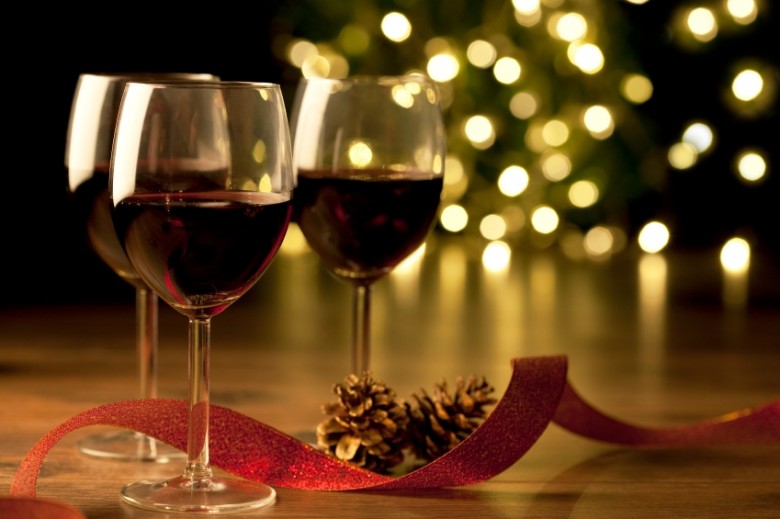 Still looking for the perfect holiday gift for your Mother, Father, Sister, Brother, Bestie and/or Hostess with the Mostess? Let's face it, this time of year the list could go on and on but there is one gift that is guaranteed never to be returned, is truly one size fits all, and will always bring a smile to the face of your recipient. Yes, you guessed it - wine!Whether the lucky recipient is just learning about wine, is a seasoned collector or you're uncertain about their specific vinous preferences here are three gift suggestions from The Wine Atelier that are sure to please:1.) The Gift of Bubbles: What beverage is the vinous equivalent of a celebration? Sparkling wine, of course! Whether it's a Cremant from the Loire Valley, a sparkler from California or the real deal, a bottle of Champagne itself, sparkling wine is always well received. You don't even have to know the vinous preferences of your recipient because at this time of year, a bottle of bubbly is always "a good thing". In addition to being wonderfully festive, it also has mass appeal and pairs deliciously well with just about any party fare. Some favorites include the Charles Bove Brut Sparkling Wine, Loire Valley, France NV ($15), the Schramsberg Blanc de Blancs, North Coast, CA ($30), and for a real statement, how about a magnum of Taittinger Brut la Francaise, Champagne, France, NV ($129).2.) The Explorateur Wine Club: is your lucky recipient looking to learn about and explore the vast and sometimes confusing world of wine? If so, let The Wine Atelier be their guide! With a gift subscription to The Wine Atelier's Explorateur Wine Club they'll get to virtually travel the globe each month when they'll receive two bottles of wine from one of the world's renowned wine regions. The wines are Sommelier Selected by yours truly and each shipment comes complete with detailed information on the producer, region, grape variety, as well as food and wine pairing suggestions for each wine. For more information on The Explorateur Wine Club ($45/month) please click here.3.) Sommelier Selected Special Bottles, Duos and Trios: for the wine lover who has everything, the only thing they can always use more of is wine! Whether they're crazy for Champagne (Holiday Champagne Duo $99) or have a passion for Pinot Noir (Passion for Pinot Noir Trio $175), our Sommelier Selected Gift Sets are sure to please! In addition to the wine, each selection includes detailed information on the producer, region, grape variety, recommended drinking window and food and wine pairing suggestions. Stylish gift wrap is also included so each selection is ready to present to the lucky recipient. For more information or to browse our Sommelier Selections, please click here!I hope we've helped make your holiday shopping a little easier and remember we're only a phone call or text away to answer any of your vinous holiday questions at 561.317.6663 ~ Happy Shopping!Cheers,
Still looking for the perfect holiday gift for your Mother, Father, Sister, Brother, Bestie and/or Hostess with the Mostess? Let's face it, this time of year the list could go on and on but there is one gift that is guaranteed never to be returned, is truly one size fits all, and will always bring a smile to the face of your recipient. Yes, you guessed it - wine!Whether the lucky recipient is just learning about wine, is a seasoned collector or you're uncertain about their specific vinous preferences here are three gift suggestions from The Wine Atelier that are sure to please:1.) The Gift of Bubbles: What beverage is the vinous equivalent of a celebration? Sparkling wine, of course! Whether it's a Cremant from the Loire Valley, a sparkler from California or the real deal, a bottle of Champagne itself, sparkling wine is always well received. You don't even have to know the vinous preferences of your recipient because at this time of year, a bottle of bubbly is always "a good thing". In addition to being wonderfully festive, it also has mass appeal and pairs deliciously well with just about any party fare. Some favorites include the Charles Bove Brut Sparkling Wine, Loire Valley, France NV ($15), the Schramsberg Blanc de Blancs, North Coast, CA ($30), and for a real statement, how about a magnum of Taittinger Brut la Francaise, Champagne, France, NV ($129).2.) The Explorateur Wine Club: is your lucky recipient looking to learn about and explore the vast and sometimes confusing world of wine? If so, let The Wine Atelier be their guide! With a gift subscription to The Wine Atelier's Explorateur Wine Club they'll get to virtually travel the globe each month when they'll receive two bottles of wine from one of the world's renowned wine regions. The wines are Sommelier Selected by yours truly and each shipment comes complete with detailed information on the producer, region, grape variety, as well as food and wine pairing suggestions for each wine. For more information on The Explorateur Wine Club ($45/month) please click here.3.) Sommelier Selected Special Bottles, Duos and Trios: for the wine lover who has everything, the only thing they can always use more of is wine! Whether they're crazy for Champagne (Holiday Champagne Duo $99) or have a passion for Pinot Noir (Passion for Pinot Noir Trio $175), our Sommelier Selected Gift Sets are sure to please! In addition to the wine, each selection includes detailed information on the producer, region, grape variety, recommended drinking window and food and wine pairing suggestions. Stylish gift wrap is also included so each selection is ready to present to the lucky recipient. For more information or to browse our Sommelier Selections, please click here!I hope we've helped make your holiday shopping a little easier and remember we're only a phone call or text away to answer any of your vinous holiday questions at 561.317.6663 ~ Happy Shopping!Cheers,

Still looking for the perfect holiday gift for your Mother, Father, Sister, Brother, Bestie and/or Hostess with the Mostess? Let’s face it, this time of year the list could go on and on but there is one gift that is guaranteed never to be returned, is truly one size fits all, and will always bring a smile to the face of your recipient. Yes, you guessed it – wine!
Whether the lucky recipient is just learning about wine, is a seasoned collector or you’re uncertain about their specific vinous preferences here are three gift suggestions from The Wine Atelier that are sure to please:
1.) The Gift of Bubbles: What beverage is the vinous equivalent of a celebration? Sparkling wine, of course! Whether it’s a Cremant from the Loire Valley, a sparkler from California or the real deal, a bottle of Champagne itself, sparkling wine is always well received. You don’t even have to know the vinous preferences of your recipient because at this time of year, a bottle of bubbly is always “a good thing”. In addition to being wonderfully festive, it also has mass appeal and pairs deliciously well with just about any party fare. Some favorites include the Charles Bove Brut Sparkling Wine, Loire Valley, France NV ($15), the Schramsberg Blanc de Blancs, North Coast, CA ($30), and for a real statement, how about a magnum of Taittinger Brut la Francaise, Champagne, France, NV ($129).
2.) The Explorateur Wine Club: is your lucky recipient looking to learn about and explore the vast and sometimes confusing world of wine? If so, let The Wine Atelier be their guide! With a gift subscription to The Wine Atelier’s Explorateur Wine Club they’ll get to virtually travel the globe each month when they’ll receive two bottles of wine from one of the world’s renowned wine regions. The wines are Sommelier Selected by yours truly and each shipment comes complete with detailed information on the producer, region, grape variety, as well as food and wine pairing suggestions for each wine. For more information on The Explorateur Wine Club ($45/month) please click here.
3.) Sommelier Selected Special Bottles, Duos and Trios: for the wine lover who has everything, the only thing they can always use more of is wine! Whether they’re crazy for Champagne (Holiday Champagne Duo $99) or have a passion for Pinot Noir (Passion for Pinot Noir Trio $175), our Sommelier Selected Gift Sets are sure to please! In addition to the wine, each selection includes detailed information on the producer, region, grape variety, recommended drinking window and food and wine pairing suggestions. Stylish gift wrap is also included so each selection is ready to present to the lucky recipient. For more information or to browse our Sommelier Selections, please click here!
I hope we’ve helped make your holiday shopping a little easier and remember we’re only a phone call or text away to answer any of your vinous holiday questions at 561.317.6663 ~ Happy Shopping!
Cheers,
![]()